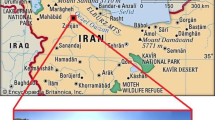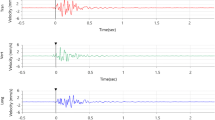Abstract
Blasting generates undesirable ground vibration with adverse effects on humans, the environment, and structures. Numerous studies have used various techniques including machine learning (ML) to predict the peak particle velocity (PPV) caused by blasting in surface mines. These studies used the validation-set approach to evaluate the performance of their predictive models. In this study, Random Forest (RF), Gaussian Process (GP), and Gradient Boosting Machine (GBM) were applied for the prediction of PPV using data from a large open-pit gold mine in Ghana. An ensemble model based on a stacked generalization approach was then built on these three base models to significantly improve the PPV prediction performance. The model evaluation was done using repeated tenfold cross-validation which resolves the challenges with the validation-set approach for small datasets. The dataset used in this study comprised a total of 196 measurements taken from different blasting operations. R-squared (\({R}^{2}\)), mean absolute error (MAE), and root mean square error (RMSE) were used to evaluate the model performance. The results obtained from these models revealed that all the base models did not significantly outperform each other. However, the stacked generalization approach had a better performance, with RMSE = 0.12, R2 = 0.96, and MAE = 0.07. This approach presented an improvement over the existing methods and will be useful for highly accurate predictions of ground vibration during blast design. The application of this model will be useful for efficient and effective blast design.










Similar content being viewed by others
References
Singh TN, Singh V (2005) An intelligent approach to prediction and control ground vibration in mines. Geotech Geol Eng 23(3):249–262. https://doi.org/10.1007/s10706-004-7068-x
Hasanipanah M, JahedArmaghani D, BakhshandehAmnieh H, Majid MZA, Tahir MMD (2017) Application of PSO to develop a powerful equation for prediction of flyrock due to blasting. Neural Comput Appl 289(1):1043–1050. https://doi.org/10.1007/s00521-016-2434-1
Singh TN, Verma AK (2010) “Sensitivity of total charge and maximum charge per delay on ground vibration”, Geomatics. Nat Hazards Risk 1(3):259–272. https://doi.org/10.1080/19475705.2010.488352
Ghasemi E, Sari M, Ataei M (2012) Development of an empirical model for predicting the effects of controllable blasting parameters on flyrock distance in surface mines. Int J Rock Mech Min Sci 52:163–170. https://doi.org/10.1016/j.ijrmms.2012.03.011
Monjezi M, Mehrdanesh A, Malek A, Khandelwal M (2013) Evaluation of effect of blast design parameters on flyrock using artificial neural networks. Neural Comput Appl 23(2):349–356. https://doi.org/10.1007/s00521-012-0917-2
JahedArmaghani D, Hasanipanah M, Tonnizam Mohamad E (2016) A combination of the ICA-ANN model to predict air-overpressure resulting from blasting. Eng Comput 32(1):155–171. https://doi.org/10.1007/s00366-015-0408-z
Monjezi M, Hasanipanah M, Khandelwal M (2013) Evaluation and prediction of blast-induced ground vibration at Shur River Dam, Iran, by artificial neural network. Neural Comput Appl 22(7–8):1637–1643. https://doi.org/10.1007/s00521-012-0856-y
Hasanipanah M, Monjezi M, Shahnazar A, JahedArmaghani D, Farazmand A (2015) Feasibility of indirect determination of blast induced ground vibration based on support vector machine. Meas J Int Meas Confed 75:289–297. https://doi.org/10.1016/j.measurement.2015.07.019
Hasanipanah M, JahedArmaghani D, Khamesi H, BakhshandehAmnieh H, Ghoraba S (2016) Several non-linear models in estimating air-overpressure resulting from mine blasting. Eng Comput 32(3):441–455. https://doi.org/10.1007/s00366-015-0425-y
JahedArmaghani D, Tonnizam Mohamad E, Hajihassani M, AlaviNezhad Khalil Abad SV, Marto A, Moghaddam MR (2016) Evaluation and prediction of flyrock resulting from blasting operations using empirical and computational methods. Eng Comput 32(1):109–121. https://doi.org/10.1007/s00366-015-0402-5
Marto A, Hajihassani M, Jahed Armaghani D, Tonnizam Mohamad E, Makhtar AM (2014) A novel approach for blast-induced flyrock prediction based on imperialist competitive algorithm and artificial neural network. Sci World J 2014. https://doi.org/10.1155/2014/643715
Ding Z, Nguyen H, Bui XN, Zhou J, Moayedi H (2020) Computational intelligence model for estimating intensity of blast-induced ground vibration in a mine based on imperialist competitive and extreme gradient boosting algorithms. Nat Resour Res 29(2):751–769. https://doi.org/10.1007/s11053-019-09548-8
Fouladgar N, Hasanipanah M, BakhshandehAmnieh H (2017) Application of cuckoo search algorithm to estimate peak particle velocity in mine blasting. Eng Comput 33(2):181–189. https://doi.org/10.1007/s00366-016-0463-0
Ghasemi E, Kalhori H, Bagherpour R (2016) A new hybrid ANFIS–PSO model for prediction of peak particle velocity due to bench blasting. Eng Comput 32(4):607–614. https://doi.org/10.1007/s00366-016-0438-1
Mokfi T, Shahnazar A, Bakhshayeshi I, Derakhsh AM, Tabrizi O (2018) Proposing of a new soft computing-based model to predict peak particle velocity induced by blasting. Eng Comput 34(4):881–888. https://doi.org/10.1007/s00366-018-0578-6
Shang Y, Nguyen H, Bui XN, Tran QH, Moayedi H (2020) A novel artificial intelligence approach to predict blast-induced ground vibration in open-pit mines based on the firefly algorithm and artificial neural network. Nat Resour Res 29(2):723–737. https://doi.org/10.1007/s11053-019-09503-7
Dawuda I, Srinivasan S (2022) Geologic modeling and ensemble-based history matching for evaluating CO2 sequestration potential in point bar reservoirs. Front Energy Res 10:10. https://doi.org/10.3389/fenrg.2022.867083
Dawuda I, Srinivasan S (2022) A hierarchical stochastic modeling approach for representing point bar geometries and petrophysical property variations. Comput Geosci 164:105127. https://doi.org/10.1016/J.CAGEO.2022.105127
Khandelwal M, Singh TN (2013) Application of an expert system to predict maximum explosive charge used per delay in surface mining. Rock Mech Rock Eng 46(6):1551–1558. https://doi.org/10.1007/s00603-013-0368-9
Singh TN, Verma AK, Sharma PK (2007) A neuro-genetic approach for prediction of time dependent deformational characteristic of rock and its sensitivity analysis. Geotech Geol Eng 25(4):395–407. https://doi.org/10.1007/s10706-006-9117-0
Bhandari S (1997) Engineering rock blasting operations. p 388
Monjezi M, Bahrami A, Varjani AY, Sayadi AR (2011) Prediction and controlling of flyrock in blasting operation using artificial neural network. Arab J Geosci 4(3–4):421–425. https://doi.org/10.1007/s12517-009-0091-8
Awejori GA, Radonjic M, Awejori GA, Radonjic M (2021) Review of geochemical and geo-mechanical impact of clay-fluid interactions relevant to hydraulic fracturing. Hydraul Fract. https://doi.org/10.5772/INTECHOPEN.98881
Rathore SS, Lakshminarayana V (2006) Studies on flyrock at limestone quarries. J Mines Met Fuels 54(6–7):130–134
Moayedi H, Hayati S (2018) Modelling and optimization of ultimate bearing capacity of strip footing near a slope by soft computing methods. Appl Soft Comput J 66:208–219. https://doi.org/10.1016/j.asoc.2018.02.027
Bui X, Jaroonpattanapong P, Nguyen H, Tran Q (2019) A novel hybrid model for predicting blast-induced ground vibration based on k-nearest neighbors and particle swarm optimization 1–14. https://doi.org/10.1038/s41598-019-50262-5
Manoj K, Monjezi M (2013) Prediction of flyrock in open pit blasting operation using machine learning method. Int J Min Sci Technol 23(3):313–316. https://doi.org/10.1016/J.IJMST.2013.05.005
Murlidhar BR et al (2021) Prediction of flyrock distance induced by mine blasting using a novel Harris Hawks optimization-based multi-layer perceptron neural network. J Rock Mech Geotech Eng 13(6):1413–1427. https://doi.org/10.1016/J.JRMGE.2021.08.005
Temeng VA, Ziggah YY, Arthur CK (2020) A novel artificial intelligent model for predicting air overpressure using brain inspired emotional neural network. Int J Min Sci Technol 30(5):683–689. https://doi.org/10.1016/J.IJMST.2020.05.020
AsmawishamAlel MN, AnakUpom MR, Abdullah RA, Zainal Abidin MH (2018) Optimizing blasting’s air overpressure prediction model using swarm intelligence. J Phys Con Ser. 995(1):012046. https://doi.org/10.1088/1742-6596/995/1/012046
Nguyen H, Bui XN (2019) Predicting blast-induced air overpressure: a robust artificial intelligence system based on artificial neural networks and random forest. Nat Resour Res 28(3):893–907. https://doi.org/10.1007/S11053-018-9424-1/FIGURES/10
Nguyen H, Bui XN, Bui HB, Cuong DT (2019) Developing an XGBoost model to predict blast-induced peak particle velocity in an open-pit mine: a case study. ActaGeophys. https://doi.org/10.1007/s11600-019-00268-4
Khandelwal M, Kankar PK, Harsha SP (2010) Evaluation and prediction of blast induced ground vibration using support vector machine. Min Sci Technol 20(1):64–70. https://doi.org/10.1016/S1674-5264(09)60162-9
Hasanipanah M, Golzar SB, Larki IA, Maryaki MY, Ghahremanians T (2017) Estimation of blast-induced ground vibration through a soft computing framework. Eng Comput 33(4):951–959. https://doi.org/10.1007/s00366-017-0508-z
Khandelwal M, Armaghani DJ, Faradonbeh RS, Yellishetty M, Majid MZA, Monjezi M (2017) Classification and regression tree technique in estimating peak particle velocity caused by blasting. Eng Comput 33(1):45–53. https://doi.org/10.1007/s00366-016-0455-0
Arthur CK, Temeng VA, Ziggah YY (2019) Novel approach to predicting blast-induced ground vibration using Gaussian process regression. Eng Comput 36(1):29–42. https://doi.org/10.1007/s00366-018-0686-3
Fişne A, Kuzu C, Hüdaverdi T (2011) Prediction of environmental impacts of quarry blasting operation using fuzzy logic. Environ Monit Assess 174(1–4):461–470. https://doi.org/10.1007/s10661-010-1470-z
Arthur CK, Temeng VA, Ziggah YY (2020) Multivariate Adaptive Regression Splines (MARS) approach to blast-induced ground vibration prediction. Int J Mining Reclam Environ 34(3):198–222. https://doi.org/10.1080/17480930.2019.1577940
Zhu W, Nikafshan Rad H, Hasanipanah M (2021) A chaos recurrent ANFIS optimized by PSO to predict ground vibration generated in rock blasting. Appl Soft Comput 108:107434. https://doi.org/10.1016/J.ASOC.2021.107434
Amiri M, Hasanipanah M, BakhshandehAmnieh H (2020) Predicting ground vibration induced by rock blasting using a novel hybrid of neural network and itemset mining. Neural Comput Appl 32(18):14681–14699. https://doi.org/10.1007/S00521-020-04822-W/FIGURES/17
Ding X, Hasanipanah M, Nikafshan Rad H, Zhou W (2021) Predicting the blast-induced vibration velocity using a bagged support vector regression optimized with firefly algorithm. Eng Comput 37(3):2273–2284. https://doi.org/10.1007/S00366-020-00937-9/FIGURES/11
Dick RA, Fletcher LR, D’Andrea DV (1983) Explosives and blasting procedures manual. Information Circular - United States, Bureau of Mines
Liu D, Lu W, Liu Y, Chen M, Yan P, Sun P (2019) Analysis of the main factors influencing the dominant frequency of blast vibration. https://doi.org/10.1155/2019/8480905
Kabwe E (2018) Velocity of detonation measurement and fragmentation analysis to evaluate blasting efficacy. J Rock Mech Geotech Eng 10(3):523–533. https://doi.org/10.1016/J.JRMGE.2017.12.003
Khandelwal M, Kumar DL, Yellishetty M (2011) Application of soft computing to predict blast-induced ground vibration. Eng Comput 27(2):117–125. https://doi.org/10.1007/S00366-009-0157-Y/TABLES/6
James G, Daniela W, Hastie T, Tibshirani R (2013) An introduction to statistical learning with application in R. Springer, New York
Rasmussen CE, Williams CKI (2006) Gaussian processes for machine learning. In: Dietterich T (ed) vol 7, issue 5. The MIT Press
Han H, Armaghani DJ, Tarinejad R, Zhou J, Tahir MM (2020) Random forest and Bayesian network techniques for probabilistic prediction of flyrock induced by blasting in quarry sites. Nat Resour Res 29(2):655–667. https://doi.org/10.1007/s11053-019-09611-4
Akinkunmi M (2019) Introduction to statistics using R. In Synthesis lectures on mathematics and statistics, vol 11, issue 4. https://doi.org/10.2200/S00899ED1V01Y201902MAS024
Prasad AM, Iverson LR, Liaw A (2006) Newer classification and regression tree techniques: bagging and random forests for ecological prediction. Ecosystems 9(2):181–199. https://doi.org/10.1007/s10021-005-0054-1
Zhang C, Ma Y (eds) (2012) Ensemble machine learning: methods and applications. Springer Science & Business Media
Touzani S, Granderson J, Fernandes S (2018) Gradient boosting machine for modeling the energy consumption of commercial buildings. Energy Build 158:1533–1543. https://doi.org/10.1016/j.enbuild.2017.11.039
Chen T, Guestrin C (2016) XGBoost: a scalable tree boosting system. Proc ACM SIGKDD Int Conf Knowl Discov Data Min 13–17:785–794. https://doi.org/10.1145/2939672.2939785
Wolpert DH (1992) Stacked generalization. Neural Netw 5(2):241–259. https://doi.org/10.1016/S0893-6080(05)80023-1
Breiman L (1996) Stacked regressions. Mach Learn 24(1):49–64. https://doi.org/10.1007/bf00117832
Boehmke B and Greenwell B (2020) Hands-on machine learning with R. https://bradleyboehmke.github.io/HOML/. Accessed 9 Jul 2020
Van Der Laan MJ, Polley EC and Hubbard AE (2007) Super learner. Stat Appl Genet Mol Biol 6(1). https://doi.org/10.2202/1544-6115.1309
Tugay R and Ögüdücü ŞG (2020) Demand prediction using machine learning methods and stacked generalization. DATA 2017 - Proc 6th Int Conf Data Sci Technol Appl 216–222. https://doi.org/10.5220/0006431602160222
Fürnkranz J et al (2011) “Mean absolute error”, in Encyclopedia of Machine Learning. Springer, US, pp 652–652
Grant M and Kenton W (2019) Coefficient of determination: overview. https://www.investopedia.com/terms/c/coefficient-of-determination.asp. Accessed 19 Dec 2019
Acknowledgements
The authors would like express appreciation to Clement Kweku Arthur, PhD, for his assistance with the acquisition of the data that was used in this study.
Author information
Authors and Affiliations
Corresponding author
Ethics declarations
Conflict of interest
The authors declare no competing interests.
Additional information
Publisher's Note
Springer Nature remains neutral with regard to jurisdictional claims in published maps and institutional affiliations.
Rights and permissions
Springer Nature or its licensor (e.g. a society or other partner) holds exclusive rights to this article under a publishing agreement with the author(s) or other rightsholder(s); author self-archiving of the accepted manuscript version of this article is solely governed by the terms of such publishing agreement and applicable law.
About this article
Cite this article
Kadingdi, F.A., Ayawah, P.E.A., Azure, J.W.A. et al. Stacked Generalization for Improved Prediction of Ground Vibration from Blasting in Open-Pit Mine Operations. Mining, Metallurgy & Exploration 39, 2351–2363 (2022). https://doi.org/10.1007/s42461-022-00698-7
Received:
Accepted:
Published:
Issue Date:
DOI: https://doi.org/10.1007/s42461-022-00698-7




